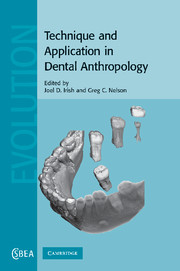Book contents
- Frontmatter
- Contents
- Contributors
- Acknowledgments
- Section I Context
- Section II Applications in assessing population health
- 4 Using perikymata to estimate the duration of growth disruptions in fossil hominin teeth: issues of methodology and interpretation
- 5 Micro spatial distributions of lead and zinc in human deciduous tooth enamel
- 6 The current state of dental decay
- 7 Dental caries prevalence by sex in prehistory: magnitude and meaning
- 8 Dental pathology prevalence and pervasiveness at Tepe Hissar: statistical utility for investigating inter-relationships between wealth, gender, and status
- Section III Applied life and population history
- Section IV Forefront of technique
- Index
- References
8 - Dental pathology prevalence and pervasiveness at Tepe Hissar: statistical utility for investigating inter-relationships between wealth, gender, and status
Published online by Cambridge University Press: 12 September 2009
- Frontmatter
- Contents
- Contributors
- Acknowledgments
- Section I Context
- Section II Applications in assessing population health
- 4 Using perikymata to estimate the duration of growth disruptions in fossil hominin teeth: issues of methodology and interpretation
- 5 Micro spatial distributions of lead and zinc in human deciduous tooth enamel
- 6 The current state of dental decay
- 7 Dental caries prevalence by sex in prehistory: magnitude and meaning
- 8 Dental pathology prevalence and pervasiveness at Tepe Hissar: statistical utility for investigating inter-relationships between wealth, gender, and status
- Section III Applied life and population history
- Section IV Forefront of technique
- Index
- References
Summary
Introduction
This contribution demonstrates how dental pathology analysis can be used to document differences in dental health that likely stem from social stratification. The case study is based on a sample of human remains from Tepe Hissar, Iran. Reflecting the overall theme of this volume, the primary emphasis of this study is to explore how dental disease prevalence based on individual counts, coupled with a new method for assessment of pervasiveness controlled for subsequent proliferation after initial insult among individuals, yields greater insight into intra-populational differences in dietary behavior.
Advances in applying analytical chemistry to archaeologically derived skeletal material has led to an upswing in studies that employ carbon and nitrogen stable isotope analysis of bone collagen to determine whether differences in dietary behavior may be found within ancient populations. These studies often couple sex identification with the artifacts associated with individuals to determine if dietary differences correspond to assumed differences in wealth status (Ambrose et al., 2003; Dürrwächter et al, 2006; Jay and Richard, 2006; Le Huray and Schutkowsky, 2005; Murray and Schoeninger, 1988; Ubelaker et al, 1995).
While such studies provide a powerful tool for assessing the impact of social divisions in past populations, it is sometimes impossible to perform destructive analyses. In such cases, alternative procedures to determine whether elites suffered less from disease (Hatch and Geidel, 1983; Robb et al., 2001; Storey, 1998), or enjoyed longer lives have been employed (Cook, 1981; Šlaus, 2000; Storey, 1998; Sullivan, 2004).
- Type
- Chapter
- Information
- Technique and Application in Dental Anthropology , pp. 178 - 216Publisher: Cambridge University PressPrint publication year: 2008



